Does The Best American Comics Deliver the Best?
The Best American Comics series began with the 2006 edition, edited by the late Harvey Pekar. The
Best American line has long been the standard for celebrating the best in any printed genre, from
The Best American Poetry to
The Best American Mystery Stories. So the question that inevitably will be asked when you title your book
The Best American… is whether this is the best stuff. The answer for
Best American Comics 2013 is yes and no.
First, a little background might be necessary. Each year a different editor is selected to cull through the shortlist of works chosen by the series editors. Creators and spouses Matt Madden and Jessica Abel (
Drawing Words and Writing Pictures) have been the series editors for six volumes and this year Jeff Smith, the writer-artist of
Bone and
RASL, is the editor. The work published in
BAC 2013 was actually originally published between late 2011 and mid-2012.
[caption id="" align="aligncenter" width="360"]
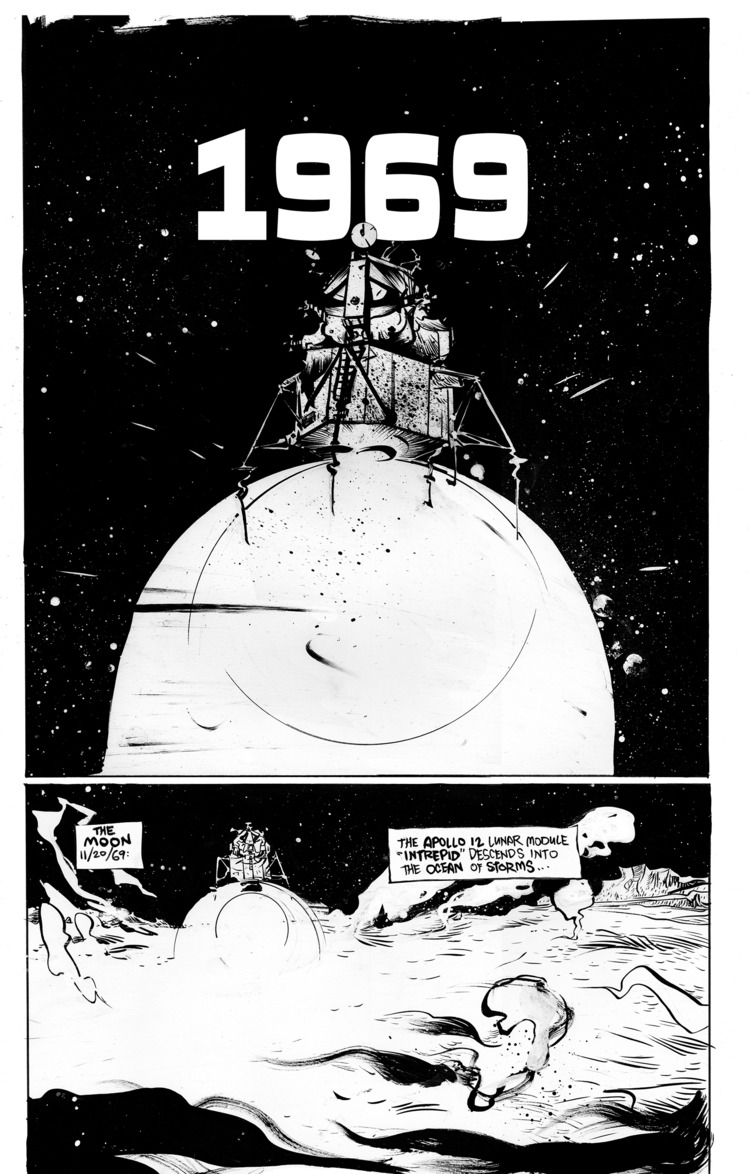
From Paul Pope's "1969"[/caption]
I’ve always maintained that if this (or any of the
Best American series) was titled
Some of the Best American Comics, there would be less criticism. It’s the superlative that invites some of the resistance that any of the titles invariably get. Certainly, one could make an argument that it’s somewhat silly to pick a handful of artistic works and call them the “best.” It doesn’t account for particular taste and it doesn’t account for personality of the selector.
On the other hand, there’s a long history of picking the best in creative entertainment. Now that we’re approaching December, many media outlets will be selecting the best movies, music, television shows and, yes, comics of the year. Additionally,
The Best American title is clever marketing precisely because of its slightly controversial title. Good comics deserve to get seen by a wide audience and if putting them in a book called
The Best American Comics helps, it’s a great idea.
[caption id="" align="aligncenter" width="290"]
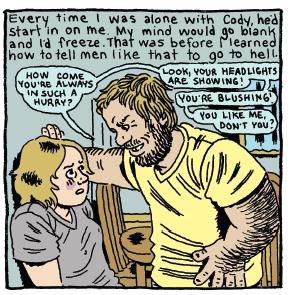
From Gabrielle Bell's "Cody"[/caption]
Once a publisher (Houghton Mifflin Harcourt in this case) takes the title
Best American, I do think it’s fair to critique the choices. Allowing for some variations in taste, do the comics in
The Best American Comics 2013 represent the best? As I mentioned at the start, I think you could say that many of the works here are outstanding and deserve to be highlighted among the best. At the same time, there’s a large chunk of comics underrepresented, and I think that’s puzzling.
When I reviewed
the first volume of Best American Comics, I lamented that there seemed to be a sharp demarcation between indie/literary/art comics and the mainstream comic book publishers. Including this year’s edition, I have read half of the
Best American Comics books published (four of eight), and none of those featured superhero comics prominently. Honestly, I don’t recall any. There is certainly nothing by Marvel or DC published in
BAC 2013.
[caption id="" align="aligncenter" width="317"]
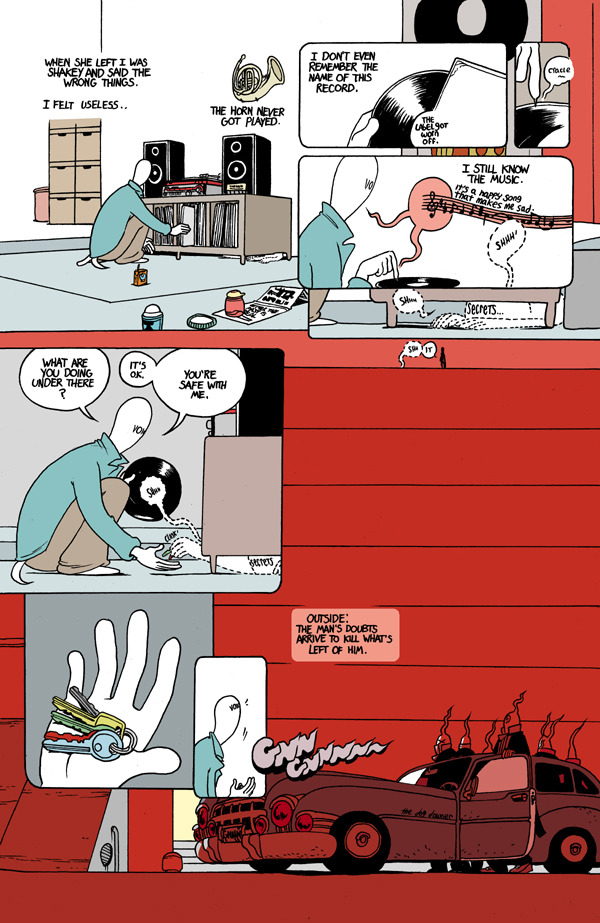
From Brandon Graham's "The Speaker"[/caption]
Not only are superhero comics not represented but neither are non-superhero comics published by companies like Image, IDW, Dynamite or DC’s Vertigo line. There are actually four comics included in this year’s BAC edition from Dark Horse’s compilation series Dark Horse Presents. It’s great that this quality title is celebrated, but there are no selection from regular Dark Horse series.
It’s also worth noting that
Saga by Brian K. Vaughan and Fiona Staples, which has cleaned up awards since its debut, began in March 2012, so the first few issues were eligible to be included for this
BAC volume. It’s not even listed in the “Notable Comics” appendix of about 100 additional titles that were considered for the volume.
Locke & Key by Joe Hill and Gabriel Rodriguez is listed in this appendix, as is Darwyn Cooke’s
Richard Stark’s Parker: The Score, but neither is included in the book itself.
[caption id="" align="aligncenter" width="348"]

From Malachi Ward's "Top Five"[/caption]
I think this is an unfortunate trend, separating comics. I believe that more and more readers are eager to read comics of all kinds. Even if readers of MOME and indie comics don’t read Avengers or Action Comics, they still may like titles like Fables (Vertigo) or Saga. The Best American Comics 2010 was edited by Neil Gaiman, but I wonder if The Sandman was published today, would it even be included in these volumes?
Madden and Abel mention in their “Foreward” that one of the points of the volume is to draw in new readers, but it seems like a book with only a few types of comics (the comics included are mostly dramatic, slice of life, gag or surrealistic) will not bring in all types of readers of comics. I’d rather a reader of Scott Snyder’s
Batman get introduced to Kate Beaton’s work than think “Oh,
Best American Comics is just for indie comics.”
[caption id="" align="aligncenter" width="502"]
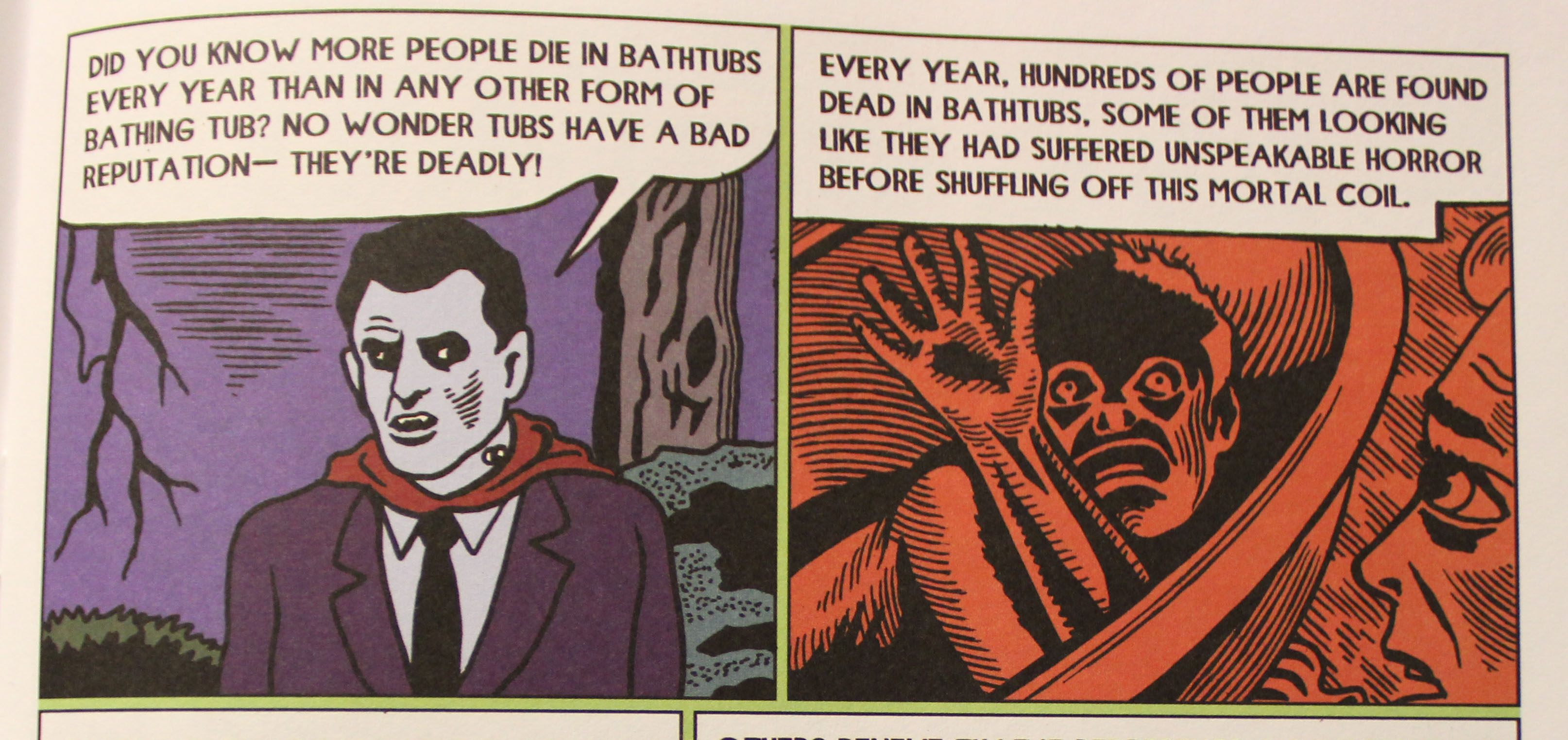
From Michael Kupperman's "Scary Bathtub Stories"[/caption]
Speaking of the work that
is included, most of it is very good. Despite the absences I’ve mentioned, Jeff Smith has worked to include artists of very different styles in this book. Paul Pope’s “1969,” a story about the moon landing from that year, is detailed and fluid in the way that Pope does so well. Brandon Graham’s snaky, anthropomorphic illustrations (and tendency towards puns) works well in “The Speaker.” Gabrielle Bell’s expressive and color work is well contrasted by the sneakily dark story in “Cody.”
There are a number of excerpts here, which is tricky. Some of them are compelling. Selections from Faith Erin Hicks’
Friends with Boys and Derf Backderf’s
My Friend Dahmer show enough to entice the reader towards the books. On the other hand, excerpts from Alison Bechdel’s
Are You My Mother? and Leela Corman’s
Unterzakhn are interesting, but don’t work as well as self-contained stories.
[caption id="" align="aligncenter" width="300"]
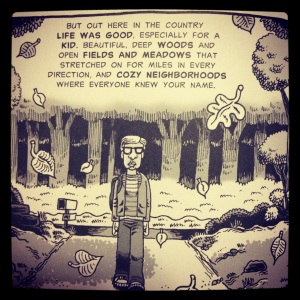
From Derf Backderf's "My Friend Dahmer"[/caption]
Although I feel like there were a number of humor/gag comics in this volume that didn’t work for me, I do quite like Beaton’s “Velocipede” from her book
Hark!, A Vagrant and Michael Kupperman’s “Scary Bathtub Stories” from
Tales Designed to Thrizzle. Of the creators I didn’t already know, the ones who impressed the most were Laura Park (“George”), Malachi Ward (“Top Five”) and Eleanor Davis (“Nita Goes Home”).
Overall, I think
Best American Comics 2013 is definitely worth a read no matter what kind of comics you like. There will be some (maybe even most) comics that don’t wow you, but there will still be a few (or a lot, in my case) of work that you really like. That’s the nature of compilations like this, and it’s also why they have an important purpose. They’re sort of like a Whitman’s Sampler of comics. Now if they could just start including ALL kinds of comic books, I think the series would be even better.
 From Paul Pope's "1969"[/caption]
I’ve always maintained that if this (or any of the Best American series) was titled Some of the Best American Comics, there would be less criticism. It’s the superlative that invites some of the resistance that any of the titles invariably get. Certainly, one could make an argument that it’s somewhat silly to pick a handful of artistic works and call them the “best.” It doesn’t account for particular taste and it doesn’t account for personality of the selector.
On the other hand, there’s a long history of picking the best in creative entertainment. Now that we’re approaching December, many media outlets will be selecting the best movies, music, television shows and, yes, comics of the year. Additionally, The Best American title is clever marketing precisely because of its slightly controversial title. Good comics deserve to get seen by a wide audience and if putting them in a book called The Best American Comics helps, it’s a great idea.
[caption id="" align="aligncenter" width="290"]
From Paul Pope's "1969"[/caption]
I’ve always maintained that if this (or any of the Best American series) was titled Some of the Best American Comics, there would be less criticism. It’s the superlative that invites some of the resistance that any of the titles invariably get. Certainly, one could make an argument that it’s somewhat silly to pick a handful of artistic works and call them the “best.” It doesn’t account for particular taste and it doesn’t account for personality of the selector.
On the other hand, there’s a long history of picking the best in creative entertainment. Now that we’re approaching December, many media outlets will be selecting the best movies, music, television shows and, yes, comics of the year. Additionally, The Best American title is clever marketing precisely because of its slightly controversial title. Good comics deserve to get seen by a wide audience and if putting them in a book called The Best American Comics helps, it’s a great idea.
[caption id="" align="aligncenter" width="290"] From Gabrielle Bell's "Cody"[/caption]
Once a publisher (Houghton Mifflin Harcourt in this case) takes the title Best American, I do think it’s fair to critique the choices. Allowing for some variations in taste, do the comics in The Best American Comics 2013 represent the best? As I mentioned at the start, I think you could say that many of the works here are outstanding and deserve to be highlighted among the best. At the same time, there’s a large chunk of comics underrepresented, and I think that’s puzzling.
When I reviewed the first volume of Best American Comics, I lamented that there seemed to be a sharp demarcation between indie/literary/art comics and the mainstream comic book publishers. Including this year’s edition, I have read half of the Best American Comics books published (four of eight), and none of those featured superhero comics prominently. Honestly, I don’t recall any. There is certainly nothing by Marvel or DC published in BAC 2013.
[caption id="" align="aligncenter" width="317"]
From Gabrielle Bell's "Cody"[/caption]
Once a publisher (Houghton Mifflin Harcourt in this case) takes the title Best American, I do think it’s fair to critique the choices. Allowing for some variations in taste, do the comics in The Best American Comics 2013 represent the best? As I mentioned at the start, I think you could say that many of the works here are outstanding and deserve to be highlighted among the best. At the same time, there’s a large chunk of comics underrepresented, and I think that’s puzzling.
When I reviewed the first volume of Best American Comics, I lamented that there seemed to be a sharp demarcation between indie/literary/art comics and the mainstream comic book publishers. Including this year’s edition, I have read half of the Best American Comics books published (four of eight), and none of those featured superhero comics prominently. Honestly, I don’t recall any. There is certainly nothing by Marvel or DC published in BAC 2013.
[caption id="" align="aligncenter" width="317"] From Brandon Graham's "The Speaker"[/caption]
Not only are superhero comics not represented but neither are non-superhero comics published by companies like Image, IDW, Dynamite or DC’s Vertigo line. There are actually four comics included in this year’s BAC edition from Dark Horse’s compilation series Dark Horse Presents. It’s great that this quality title is celebrated, but there are no selection from regular Dark Horse series.
It’s also worth noting that Saga by Brian K. Vaughan and Fiona Staples, which has cleaned up awards since its debut, began in March 2012, so the first few issues were eligible to be included for this BAC volume. It’s not even listed in the “Notable Comics” appendix of about 100 additional titles that were considered for the volume. Locke & Key by Joe Hill and Gabriel Rodriguez is listed in this appendix, as is Darwyn Cooke’s Richard Stark’s Parker: The Score, but neither is included in the book itself.
[caption id="" align="aligncenter" width="348"]
From Brandon Graham's "The Speaker"[/caption]
Not only are superhero comics not represented but neither are non-superhero comics published by companies like Image, IDW, Dynamite or DC’s Vertigo line. There are actually four comics included in this year’s BAC edition from Dark Horse’s compilation series Dark Horse Presents. It’s great that this quality title is celebrated, but there are no selection from regular Dark Horse series.
It’s also worth noting that Saga by Brian K. Vaughan and Fiona Staples, which has cleaned up awards since its debut, began in March 2012, so the first few issues were eligible to be included for this BAC volume. It’s not even listed in the “Notable Comics” appendix of about 100 additional titles that were considered for the volume. Locke & Key by Joe Hill and Gabriel Rodriguez is listed in this appendix, as is Darwyn Cooke’s Richard Stark’s Parker: The Score, but neither is included in the book itself.
[caption id="" align="aligncenter" width="348"] From Malachi Ward's "Top Five"[/caption]
I think this is an unfortunate trend, separating comics. I believe that more and more readers are eager to read comics of all kinds. Even if readers of MOME and indie comics don’t read Avengers or Action Comics, they still may like titles like Fables (Vertigo) or Saga. The Best American Comics 2010 was edited by Neil Gaiman, but I wonder if The Sandman was published today, would it even be included in these volumes?
Madden and Abel mention in their “Foreward” that one of the points of the volume is to draw in new readers, but it seems like a book with only a few types of comics (the comics included are mostly dramatic, slice of life, gag or surrealistic) will not bring in all types of readers of comics. I’d rather a reader of Scott Snyder’s Batman get introduced to Kate Beaton’s work than think “Oh, Best American Comics is just for indie comics.”
[caption id="" align="aligncenter" width="502"]
From Malachi Ward's "Top Five"[/caption]
I think this is an unfortunate trend, separating comics. I believe that more and more readers are eager to read comics of all kinds. Even if readers of MOME and indie comics don’t read Avengers or Action Comics, they still may like titles like Fables (Vertigo) or Saga. The Best American Comics 2010 was edited by Neil Gaiman, but I wonder if The Sandman was published today, would it even be included in these volumes?
Madden and Abel mention in their “Foreward” that one of the points of the volume is to draw in new readers, but it seems like a book with only a few types of comics (the comics included are mostly dramatic, slice of life, gag or surrealistic) will not bring in all types of readers of comics. I’d rather a reader of Scott Snyder’s Batman get introduced to Kate Beaton’s work than think “Oh, Best American Comics is just for indie comics.”
[caption id="" align="aligncenter" width="502"] From Michael Kupperman's "Scary Bathtub Stories"[/caption]
Speaking of the work that is included, most of it is very good. Despite the absences I’ve mentioned, Jeff Smith has worked to include artists of very different styles in this book. Paul Pope’s “1969,” a story about the moon landing from that year, is detailed and fluid in the way that Pope does so well. Brandon Graham’s snaky, anthropomorphic illustrations (and tendency towards puns) works well in “The Speaker.” Gabrielle Bell’s expressive and color work is well contrasted by the sneakily dark story in “Cody.”
There are a number of excerpts here, which is tricky. Some of them are compelling. Selections from Faith Erin Hicks’ Friends with Boys and Derf Backderf’s My Friend Dahmer show enough to entice the reader towards the books. On the other hand, excerpts from Alison Bechdel’s Are You My Mother? and Leela Corman’s Unterzakhn are interesting, but don’t work as well as self-contained stories.
[caption id="" align="aligncenter" width="300"]
From Michael Kupperman's "Scary Bathtub Stories"[/caption]
Speaking of the work that is included, most of it is very good. Despite the absences I’ve mentioned, Jeff Smith has worked to include artists of very different styles in this book. Paul Pope’s “1969,” a story about the moon landing from that year, is detailed and fluid in the way that Pope does so well. Brandon Graham’s snaky, anthropomorphic illustrations (and tendency towards puns) works well in “The Speaker.” Gabrielle Bell’s expressive and color work is well contrasted by the sneakily dark story in “Cody.”
There are a number of excerpts here, which is tricky. Some of them are compelling. Selections from Faith Erin Hicks’ Friends with Boys and Derf Backderf’s My Friend Dahmer show enough to entice the reader towards the books. On the other hand, excerpts from Alison Bechdel’s Are You My Mother? and Leela Corman’s Unterzakhn are interesting, but don’t work as well as self-contained stories.
[caption id="" align="aligncenter" width="300"] From Derf Backderf's "My Friend Dahmer"[/caption]
Although I feel like there were a number of humor/gag comics in this volume that didn’t work for me, I do quite like Beaton’s “Velocipede” from her book Hark!, A Vagrant and Michael Kupperman’s “Scary Bathtub Stories” from Tales Designed to Thrizzle. Of the creators I didn’t already know, the ones who impressed the most were Laura Park (“George”), Malachi Ward (“Top Five”) and Eleanor Davis (“Nita Goes Home”).
Overall, I think Best American Comics 2013 is definitely worth a read no matter what kind of comics you like. There will be some (maybe even most) comics that don’t wow you, but there will still be a few (or a lot, in my case) of work that you really like. That’s the nature of compilations like this, and it’s also why they have an important purpose. They’re sort of like a Whitman’s Sampler of comics. Now if they could just start including ALL kinds of comic books, I think the series would be even better.
From Derf Backderf's "My Friend Dahmer"[/caption]
Although I feel like there were a number of humor/gag comics in this volume that didn’t work for me, I do quite like Beaton’s “Velocipede” from her book Hark!, A Vagrant and Michael Kupperman’s “Scary Bathtub Stories” from Tales Designed to Thrizzle. Of the creators I didn’t already know, the ones who impressed the most were Laura Park (“George”), Malachi Ward (“Top Five”) and Eleanor Davis (“Nita Goes Home”).
Overall, I think Best American Comics 2013 is definitely worth a read no matter what kind of comics you like. There will be some (maybe even most) comics that don’t wow you, but there will still be a few (or a lot, in my case) of work that you really like. That’s the nature of compilations like this, and it’s also why they have an important purpose. They’re sort of like a Whitman’s Sampler of comics. Now if they could just start including ALL kinds of comic books, I think the series would be even better.